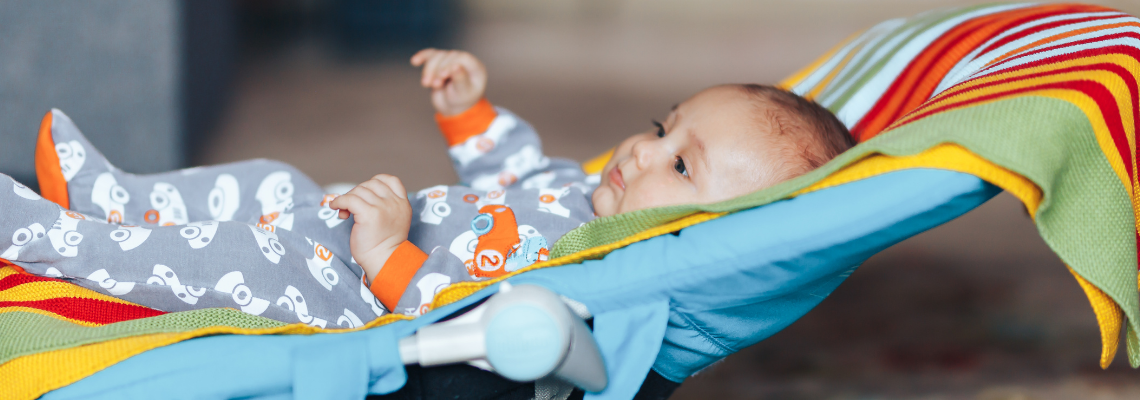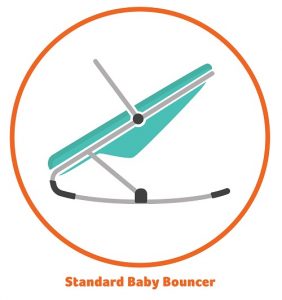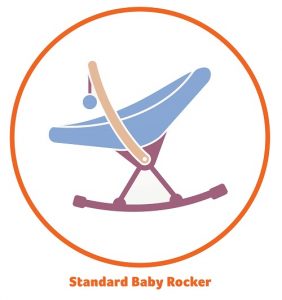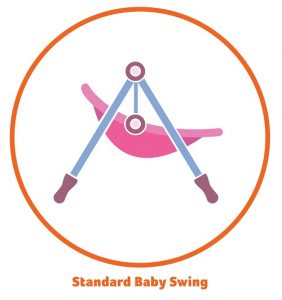
Baby bouncers, rockers and swings are a great way to keep your baby happy and content while freeing up your hands for a bit of time. Like most baby items, there are many different styles and choices available on the market and finding the right one for you and baby’s needs can be challenging with so many to choose from. For those couples looking to sort through the veritable plethora of options on the market, here are some shopping tips for finding the best baby bouncer, rocker or swing to fit your family’s lifestyle.
Before making your purchase, it’s important to know the intended purpose of your bouncer, rocker or swing. While many parents rely on these types of items to get through portions of the day, it should be noted that these types of items should not be intended for long-term sleeping options through the night, nor should they be used for prolonged use for hours at a time. That being said, determine first, how the item will be used; to occupy a child during the daytime, give them a place to rest and prepare for a nap, provide a calming solution when baby gets fussy, or simply provide a little fun while baby hangs out a bit, having this answer ahead of time will help immensely during your shopping search.
While all three of these items are not considered a necessity when it comes to baby items, they can feel like a bit of a life saver when it comes time to soothing a fussy baby or having a little break with both hands free.
In general, all three of these items are designed to emulate the feeling of being rocked, can offer a variety of additional calming or entertaining features for baby and should be used in moderation.
 Bouncers:
Bouncers:
While this type of baby item imitates a soothing motion, more so, they simulate springy, bouncing movements, thus their name. Because of the active type of movement these types of items are intended for playtime and awake moments for baby. The importance of these being used for a playful baby is that the movement of the bouncer is set in motion by the baby’s own movements or by giving it a light nudge, allowing an opportunity for baby to enjoy a little exercise as they have fun with making bouncing and jumping motions.
 Rockers:
Rockers:
Exactly as it sounds, baby rockers usually gently glide back and forth while baby lays in a small cradle or reclined chair on a slanted, yet horizontal position. This rocking chair motion provides baby a place where they can relax, be soothed after feeding or simply enjoy looking around or playing with toy accessories. These rockers can typically come in a variety of styles that can be put into motion manually or by a power source depending on the style.
Swings:
 These types of movement seats are typically mechanically powered and can either swing from side to side, front to back, circular, or a combination of all three. These seats are generally a nicely padded chair intended for babies to lay back or sit more upright in, to enjoy the rocking motions of varied speeds. Due to their variety of movement specifications these tend to be best at soothing colicky babies.
These types of movement seats are typically mechanically powered and can either swing from side to side, front to back, circular, or a combination of all three. These seats are generally a nicely padded chair intended for babies to lay back or sit more upright in, to enjoy the rocking motions of varied speeds. Due to their variety of movement specifications these tend to be best at soothing colicky babies.
In addition to set bouncers, rockers and swings, some combination swings offer integration functionality of two types of chairs, serving also as a bouncer, rocker, cradle or glider.
These can be a great addition for baby’s daily activities, and offer parents a little break from carrying or rocking baby. As with all such equipment, baby bouncers, rockers and swings should be used only with adult supervision and should follow all safety and use recommendations.
Keeping in mind that every baby is different, and no one items fits all of them perfectly, to help you on your way to finding the perfect item for baby to enjoy, below are a few things to consider when deciding between a bouncer, rocker or swing.
As a rule of thumb, newborn babies aren’t huge fans of being put down, and while a baby bouncer, swing or recliner doesn’t come close to substituting human cuddles, they can help keep some babies happy enough to free up your hands for a little bit of time.
When looking into size limitations for these types of seats, instead of searching for set age ranges, think weight guidelines, as newborns can weigh as little as five pounds or as much as 10 to 11 pounds.
Swings typically have a minimum weight at five pounds and a maximum weight of about 20 to 30 pounds, making it a perfect fit for the first few months of baby’s life until around six to nine months old. Depending on your model’s minimum weight you may or may not be able to use your swing right away. Keeping weight limits in mind, it may actually be unlikely your baby will be able to use the swing to the full weight limit due to mobility milestones, such as the ability to roll over, which may make the swing unsafe to use.
Rockers, like baby swings, are generally designed for newborns and babies up to six months old, prior to hitting key mobility milestones, however sometimes these types of items can be converted into a small stationary toddler chair for later use.
Bouncers, similar to swings and rockers are intended for small infants who cannot yet sit unassisted. Similar to some style of rockers, after nine months or more, the bouncer can be used as a toddler chair, giving it multi-functional use.
If you have to shop for a baby swing, bouncer or rocker, the one thing you should never compromise on is portability. Carrying a baby around is work enough, you don’t want to also have to worry about carrying around a cumbersome item with wires or large moving parts that can be challenging to maneuver.
Not only does portability offer solutions when traveling or setting up at family and friend’s houses, but it will enable you to use it in any room of your house, or even outside on the porch with minimal work.
Another consideration when looking into portability is identifying how it moves, whether by manually pushing, the use of batteries, or by plugging into an electrical outlet, convenience of operation can play a crucial role when considering portability options, especially if you’re planning on taking it with you in spaces that may not have electrical outlets nearby, such as outdoors.
Bouncers are typically lighter in weight, making them easily portable with only a small footprint of space needed to use. Manual options have no cords or plugs, and some models may even fold completely flat, making them ideal for storage and travel.
Swings, though successful at soothing a fussy baby, often require an outlet to plug in or a battery system at best, to power up. These also tend to be larger and bulkier in size. If you are looking for a swing that has portability options, look for one with wheels for easier movability, especially if it’s just for around the house.
Rockers can be a nice compromise between swings and bouncers as they are often small to medium in size and come in manual or motorized options, making them easy to operate and fairly easy to move around depending on the model you choose.
There are some standard safety considerations to keep in mind regardless of the baby item you use. Always use the safety harness provided by the item and refer to all instructions for setting up the bouncer, rocker or swing for optimal stability so it won’t tip over, fold or cause harm to baby. It can also be helpful to place nonslip pads under the baby item setup when used on tile or hard floors to prevent slipping or unwanted movement.
Many baby bouncers, rockers and swings have seat belt straps to secure baby during use and have padded straps to make them more comfortable for your child. These harness type seatbelts mean that if your child falls asleep during use, you will be able to pick them up without worrying they will fall completely out of the seat.
For chair systems that include additional accessories or toys, it is important to make sure that the included toys are firmly secured to avoid small parts from coming loose.
Another additional consideration is to change baby’s head position regularly to avoid their soft skull from developing flat spots, this is especially important if the bouncer, rocker or swing is being used for extended amounts of time.
One important but often overlooked safety recommendation comes in play when it comes to baby falling asleep. Since it’s not considered safe for babies to sleep at an angle, it’s important that if they happen to fall asleep in their swing or rocker chair, which is quite possible, it’s important to move them to a flat surface that follows safe sleep guidelines for baby.
Additionally, like any moving item, it is also important to check the bouncer, rocker or swing periodically for any loose screws, worn parts, or breaks and tighten or replace them as needed to avoid injury.
Rockers should generally be adjusted to a reclined or as close to a horizontal position as possible for babies up to four months old to prevent baby from leaning forward and possibly suffocating themselves by obstructing their airway. In addition, consider looking for a rocker that has a wider base to further alleviate the risk of tipping over.
Swings generally are expected to have a three-point harness system at the minimum, but most now feature a five-point harness. Even with a harness feature, these swings should be used on solid ground and never be placed on an elevated surface and should not be used to transport your baby or used as an infant carrier.
CLICK HERE: to read our Guide to Buying a Baby Carrier
Bouncers, like rockers should be adjusted to a reclined position and upright positions should be used only for slightly older babies. For some bouncers, height positions can be adjusted to accommodate a growing baby. Despite height adjustments however, it is important to follow weight recommendations for your model bouncer.
Finding this type of baby item with additional features can be a nice added bonus to the soothing motions. Features such as adjustable vibration, rocking speeds or intervals; white noise, music selections or sounds; and hanging, rotating or adjustable toys are all added features that can help keep babies calm and entertained. Some also include smart technology that allows you to adjust seat features and settings, or even the ability to set movement timers with the use of a mobile app. If one of these features is particularly important to you to be included, be sure to seek it out specifically, as not every bouncer, rocker or swing feature these added specifications.
When finding the best option that will work for you and baby’s needs is by looking at the accessories that the swing comes with. You will want to make sure that your baby can enjoy the swing and not just be stuck in it. Many swings come with toys that can not only entertain but also help with your child’s development.
If you have been shopping around for a bouncer, rocker, or swing, you will notice that many of these types of items are made of removable fabric seats or contain removeable seat covers that are machine-washable. This is a great way to keep the swing clean, or even allow you to simply wipe it down with a cloth when your baby is done using it. Finding a style of rocking baby item that is easy to clean, can be less hassle and allow you to spend more time with your child without worrying about an immense clean up should it become dirty.
In addition to washing instructions, it is important to pay attention to drying instructions as well. Be sure to check if fabric seats can be dried in a dryer or must air-dry as this may be an important consideration when anticipating time needed between cleaning and the next use.
Like any other baby item, be sure to follow the instructions on your particular model for temperature and cleaning guidelines and other washing instructions, and ensure that the fabric is completely dry before putting it back in place to avoid mildew or mold growth.
Like portability concerns, if you use your swing often, you will want an easy swing to assemble and disassemble. Many simple bouncers, rockers and swings come with instructions that allow you to put the swing together in less than five minutes. Ideally, once you have the item assembled, it should only take about three minutes for you to disassemble it, making it easier for you to store when not in use.


